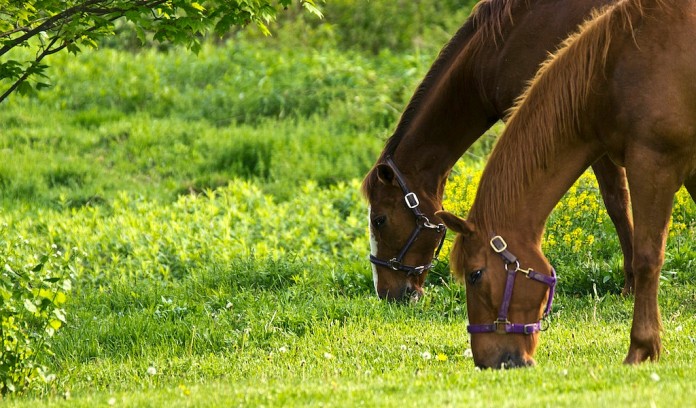We have all been experiencing this crazy winter weather and March is just starting. The weather reports that I have been following predict at least two more measurable snowstorms and some 60-degree days in the mix, before freezing again throughout the end of March.
We have been dealing with rain, snow, high winds and mud already and it is not getting any better. Livestock pastures and feeding areas have been damaged in some cases heavily, but then so have horse pastures and paddocks.
A healthy horse pasture is not only beautiful but can provide an ideal diet to keep your horses healthy. Pasture is one of the cheapest and best feeds for horses. When we maintain our pastures properly, it not only helps us, but also benefits our neighbors and our environment.
Sound horse pasture management makes good sense for the bottom line of any farm. Effective pasture management can double total forage production, making for healthier horses and lower costs for farmers.
Well-managed horse pastures provide ground cover, prevent soil erosion and decrease runoff.
The following are some tips to improve your horse pastures.
Sacrifice area
The first thing that is a must that horse owners need is to establish a sacrifice area. Sacrifice areas are key to successful pasture management, especially in situations where horses are kept on small acreage. For one or two horses, a sacrifice area can be as little as a 14’x25′ (350 sq. Feet.) fenced in area.
Horses can be kept within the sacrifice area and provided with hay and drinking water at different times throughout the year. In a sacrifice area, horses can still get their exercise with no harm to the pastures.
Extreme weather conditions, such as drought and heavy rain, create conditions that demand the use of a sacrifice area at other times.
A successful sacrifice area should include proper drainage. Maintain a slope of about 3 percent to prevent erosion. Divert all off-site flows such as barn runoff from around the area.
Waste removal
Remove waste from the site on a daily basis or before rain.
Another improvement is to fertilize and lime your pastures when your soil test calls for it. If your pastures have not been soil tested within the last two-three years, now is the time to do it.
Fertilizer and lime are nutritional supplements for the pasture grasses that will nourish your horses. Fertilizer should be spread in the fall of the year, as the grass goes dormant. This will ensure that the roots strengthen and go deeper into the soil, making for a better, more durable pasture in the spring.
Lime can be applied any time of the year but is most often applied in spring due to the availability of moisture.
Ideally, pastures should be aerated prior to liming to help absorption into the soil. One of the most important things you can do to maintain your pastures is to keep them well-covered in grass.
Trimming pasture
Keeping grasses trimmed will ensure that new growth is tender and nutritious for horses.
Cutting off overgrown and dead tops will improve root growth and increase the longevity of your pastures.
Another improvement you can make is reseeding pastures. Adding new seed to pastures whether by broadcast or drill seeding is very important in maintaining the health and stability of your grasses. Pastures should be lightly disked or harrowed first before you seed to ensure that your investment in seed has the best chance for growth.
Horses are heavy footed animals and can cause the soil in pastures to become tamped down and compacted. Aerating the soil in horse pastures can reduce compaction and give your grasses a better chance to grow and survive.
Weed control
Weed control in horse pastures is very important a couple of techniques to manage weeds include regular mowing of pastures before the weeds reach seed production stage, composting horse manure to kill weed seeds, and lastly, use a high-quality seed mix that contains a low percentage of weed seeds.
Once you have your horse pastures and paddocks established and growing, the next step is to control the when, where and how long the horses graze. Ideally, pastures should be rested as soon as the grass had been grazed down to about 2-3 inches high.
Rotational grazing is the answer if you have enough different pasture areas to do it. If you are not able to do rotational grazing then that sacrifice area becomes really important in helping to let those pastures rejuvenate before horses are returned to those pastures to graze.
Some of these small, inexpensive changes can have big improvements on not only horse pastures but livestock pastures as well. These changes can provide temporary relief to exhausted pastures until long-term fixes, such as seeding or pasture reestablishments, weed control and a soil fertility program can be implemented.














Thanks, Miss Sandy! Great “low cost” tips for we equine lovers!
Thanks and “THINK SPRING!”
Should i lime my horse pasture?